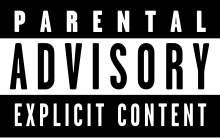Independent companies are responsible for copyright and royalties, such as:
-MCPS (Mechanical Copyright Protection Society)
-PRS (Performing Rights Society)
-Songrite UK (Copyright Office)
Ofcom can reprimand TV and Radio broadcasters for playing songs and music videos that breach its guidelines on harmful or offensive content pre-watershed.
In order for a piece of music to be used in film or television, a synchronisation license must be paid by the production to the label/artist, which clears copyright.
There is also the Parental Advisory label introduced by the Recording Industry Association of America (RIAA) and adopted by the British Phonographic Industry (BPI, of which the Big Three - Sony, UMG, Warner - are a part of).
These are placed on hard copies of audio recordings containing profanity or inappropriate references so that parents could be informed of material on albums that may be unsuitable for their children. Some online music stores also use this label such as the iTunes store. Additionally, Spotify indicate whenever a song contains explicit language with an "Explicit" label.
 |
| The Spotify 'Explicit' label that appears next to songs containing profanity |
 |
| Youtube Content Policies - Pg 1 - Please Click to Expand |
- Sexually explicit content
- Videos showing harmful or dangerous acts, particularly ones encouraging kids or viewers to do the same
- Content promoting violence against an individual or group based on religion, race, gender, sexuality, disability, age etc.
- Violent or gory content primarily intended to be shocking, sensational or gratuitous.
- Cyberbullying: abusive comments or videos
- Spam and scams
 | |
|
- Things like predatory behavior, stalking, threats, harassment, intimidation, invading privacy, revealing other people's personal information
- Infringing copyright
- Accounts established to impersonate another channel or individual
Additionally, Youtube and Vevo are working with the BBFC to rate music videos on the site. All music videos by artists signed to Sony Music UK, Universal Music UK, Warner Music UK and all UK independent labels that are unsuitable for children under 12 will be classified with a BBFC age rating, which is displayed next to the video when it is published on YouTube. This isn't required by law, however it means the companies have more integrity (as we found to be one of Sony's values in Post 1) and provides peace of mind for parents.
In order to ensure my video was suitable for audiences of 16+, as per the brief, I would not include anything that could be considered inappropriate such as smoking, drinking, sex or profanity. It also means I will generally stay away from party or club settings/scenarios in my music video, on one hand to avoid breaching these policies, on the other hand, if I were to "dumb down" these party scenarios (i.e. have no drinking) it would be unrealistic and unfaithful to the age group of my target audience and the characters in the narrative, which could alienate viewers.




No comments:
Post a Comment